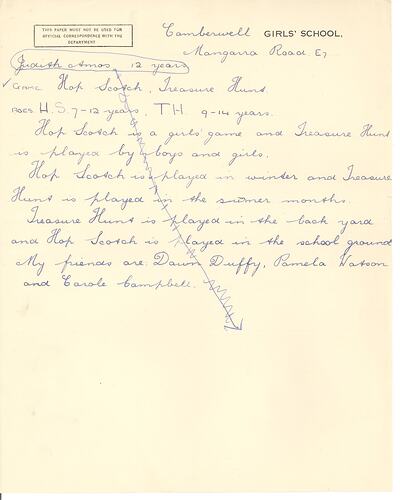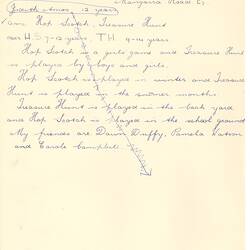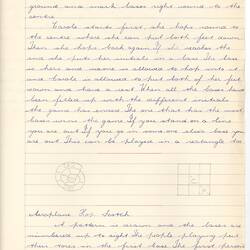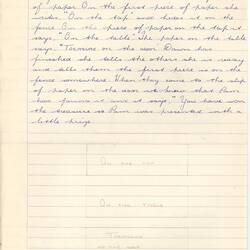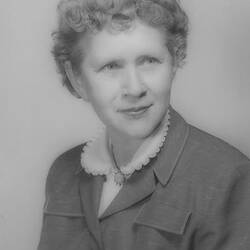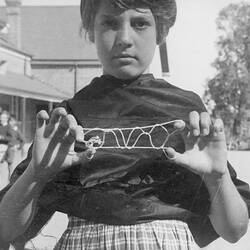Summary
Game names (and types): 'Snail Hop Scotch', 'Aeroplane Hop Scotch' (hopscotch), 'Treasure Hunt' (seeking games)
Alternative types: hopscotch patterns, taw use
Handwritten descriptions of two hopscotch patterns and the seeking game 'Treasure Hunt' composed for Dr Dorothy Howard by Judith Amos, a twelve year old student at East Camberwell Girls Secondary School, in 1954-1955. Amos provides general descriptions of Hopscotch and 'Treasure Hunt' before discussing the games in detail. She states that Hopscotch is a popular girls game played during winter in the school grounds. Amos writes that 'Treasure Hunt' is played by boys and girls in the summer months in the back gardens of children's homes. She lists some of the friends who also play these games including Dawn Duffy, Pamela Watson and Carole Campbell.
Amos describes the hopscotch patterns 'Snail Hop Scotch' and 'Aeroplane Hop Scotch' in detail, providing annotated, hand drawn diagrams of each variation. To play 'Snail Hop Scotch', Amos writes that players draw a snail-like pattern on the ground, marking bases throughout the course. As each player hops their way through the course, they write their initials in the different bases reached. Amos explains that the game continues until all the bases have been claimed by the players. She notes that landing in another player's base or on a line results in elimination from the game. Similarly, 'Aeroplane Hop Scotch' is drawn on the ground and the bases are numbered from one to eight. Players use taws, incorrectly spelt 'tores', presumably to mark out their course through the hopscotch pattern. Amos notes that players are eliminated if they land in a square occupied by another player, land in another player's base or step on a line. To play the seeking game 'Treasure Hunt', Amos writes that one player writes out a series of clues on slips of paper, which provide information about the location of a hidden treasure. The player places the clues throughout a course before providing an initial clue to the other children, who have been waiting with their eyes closed. The other players must locate each clue in order to find the final prize. Amos lists some examples of possible clues, providing an annotated diagram.
One of a collection of letters describing a children's game written to children's Folklorist Dorothy Howard between 1954 and 1955. Dr. Howard came to Australia in 1954-55 as an American Fulbright scholar to study Australian children's folklore. She travelled across Australia for 10 months collecting children's playground rhymes, games, play artefacts, etc. This letter, together with the other original fieldwork collected by Dr. Howard during this period, is preserved in the Dorothy Howard Collection manuscript files, part of the Australian Children's Folklore Collection (ACFC), Archive Series 3. The ACFC is an extensive collection documenting children's folklore and related research.
Physical Description
Handwritten game descriptions in blue ink on paper. Comprises two sheets of paper. One page features a letterhead printed in black ink; text written on one side only. Second page features four, hand drawn diagrams in pencil and text written on both sides.
More Information
-
Collection Names
Australian Children's Folklore Collection, Dorothy Howard Collection
-
Collecting Areas
-
Acquisition Information
Cultural Gifts Donation from Dr June Factor, 18 May 1999
-
Acknowledgement
Donated through the Australian Government's Cultural Gifts Program.
-
Author
Judith Amos - East Camberwell Girls' Secondary School (College), Greater Melbourne, Victoria, Australia, 1954-1955
-
Addressed To
-
Collector
-
Organisation Named
East Camberwell Girls' Secondary School (College), Mangarra Road, East Camberwell, Greater Melbourne, Victoria, Australia
-
Classification
-
Category
-
Discipline
-
Type of item
-
Overall Dimensions
203 mm (Width), 254 mm (Height)
Orientation: portrait. Dimensions include first page only.
-
Keywords
